Allison Russo is a rising political star, but where do Democrats go as Ohio gets redder?

Friends and foes describe Ohio House Minority Leader Allison Russo as smart, politically savvy and pragmatic.
The Upper Arlington Democrat flipped a state House seat in her first election. She helped pass a bipartisan budget through a chamber where Republicans outnumber Democrats nearly two to one. And she arguably decided which Republican became House Speaker in January.
"She is a chess master in a way I haven’t seen in a very long time," Ohio Democratic Party Chair Liz Walters said. "She’s got a level of strategic talent and political ability that takes others a long time to hone in this space."
Russo is what political observers would call a rising star in the Democratic Party. A hockey mom who resides in the political battleground that is suburban America and straddles the line between Gen X and millennials. The kind of politician with the background and bona fides to shape the future of politics.
"If she were the leader of the House in Pennsylvania, she would be on the shortlist for governor. She’d be on the shortlist for (U.S.) senator. She'd be on top of the list for lieutenant governor," University of Cincinnati political professor David Niven said. "But she’s in Ohio in 2023, and there aren’t a lot of open paths in front of her."
Once considered the pathway to the presidency, Ohio increasingly looks like a red state. Buckeye voters chose former President Donald Trump twice, they handed Gov. Mike DeWine a landslide reelection in 2022, and they haven't picked a Democrat outside of U.S. Sen. Sherrod Brown for nonjudicial statewide office since 2006.

"I think it’s going to be hard for her to run statewide," Ohio Republican Party Chairman Alex Triantafilou said. "I think it’s going to be hard for Sherrod Brown in 2024."
Whether Democrats can still win Ohio is a big question nationally, but it's not the only one. Cultivating a deep bench of talented candidates takes time. It takes experience, money, local connections, name ID.
Things that are hard to cultivate after term limits boot them from the statehouse. So, the question isn't so much can they win, but where do Ohio's Democratic rising stars go?
Riding the wave
Russo worked in health care policy before breaking onto Ohio's political scene in 2018. She was part of the wave of women who Walters described as active voters but "passive participants in politics" until Trump became president.
The working mother of three had a toddler, a full-time job, and sons whose hockey commitments were starting to gobble up their weekends. But she worried about the direction both Ohio and the country were taking. Trump was working to repeal the Affordable Care Act, and Ohio Republicans were debating cutbacks for Medicaid.
"She was super impressive right out of the gate," Walters said. "Allison is someone who, whether you're talking to her five times a week or are an active observer of politics, her leadership potential has always been there and been evident to folks."
That midterm election was also a good year for female Democrats. Backlash to Trump swept dozens of women into offices across the country and may have helped Russo flip her suburban Columbus seat.
"I have learned a lot of this is about timing and being ready for opportunity when it comes," she said.
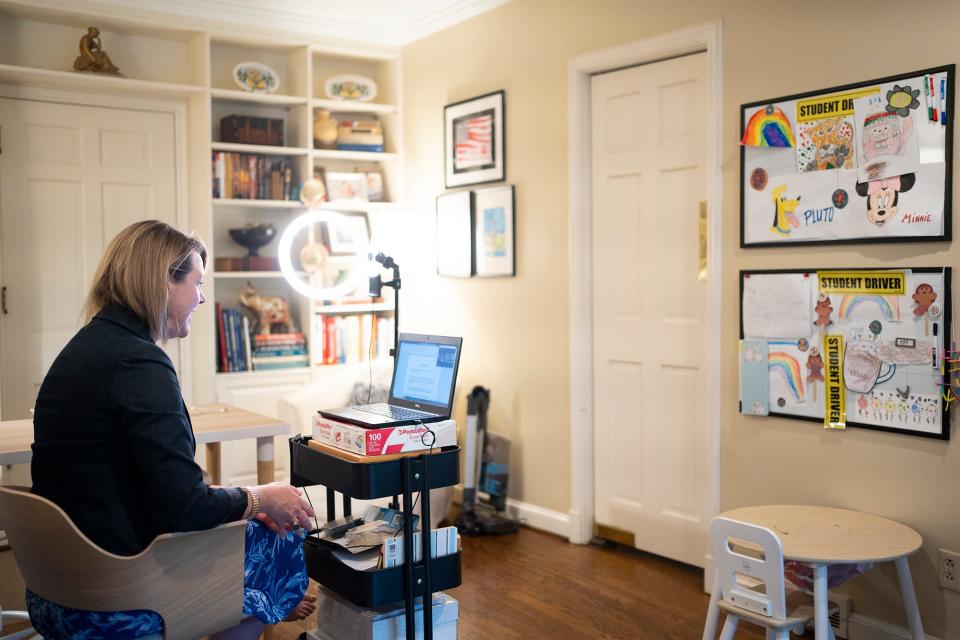
That includes the timing required to balance being a caucus leader, campaigner, wife and mother. Russo's daughter can often be heard splashing in the bathtub during phone calls. She'll respond to texts in between taking concession orders at her son's hockey games.
"So many of my constituents have seen my children grow up," she said. "It's just a normal part of the deal."
But it's not normal, at least in Ohio. Russo is the highest-ranking mother of young children in state government. All six statewide officeholders are Republican men and the lone woman in House Republican leadership is a grandmother.
"It gives her balance," Senate Minority Leader Nickie Antonio, D-Lakewood, said. "I think all the work that she’s doing at the Statehouse is to make sure things are better for her kids as they are growing up in this state."
Finding the 'least worst outcome'
The Ohio House has 32 Democrats and 67 Republicans. The GOP also controls the state Senate 25 to 7. They hold every statewide office and four of the seven state Supreme Court seats. With their supermajorities, Republicans don't need a single Democratic vote to pass a law, submit a constitutional amendment or override a gubernatorial veto.
"When you are in the minority or the super minority, you have to constantly look for opportunities to be relevant," Russo said. "You have to take those opportunities where you can."
For example, the redistricting commission tasked with drawing new legislative districts based on Ohio's updated population numbers had five Republicans and two Democrats. Republicans could, as Senate President Matt Huffman, R-Lima, said in 2022, "kind of do what we want."
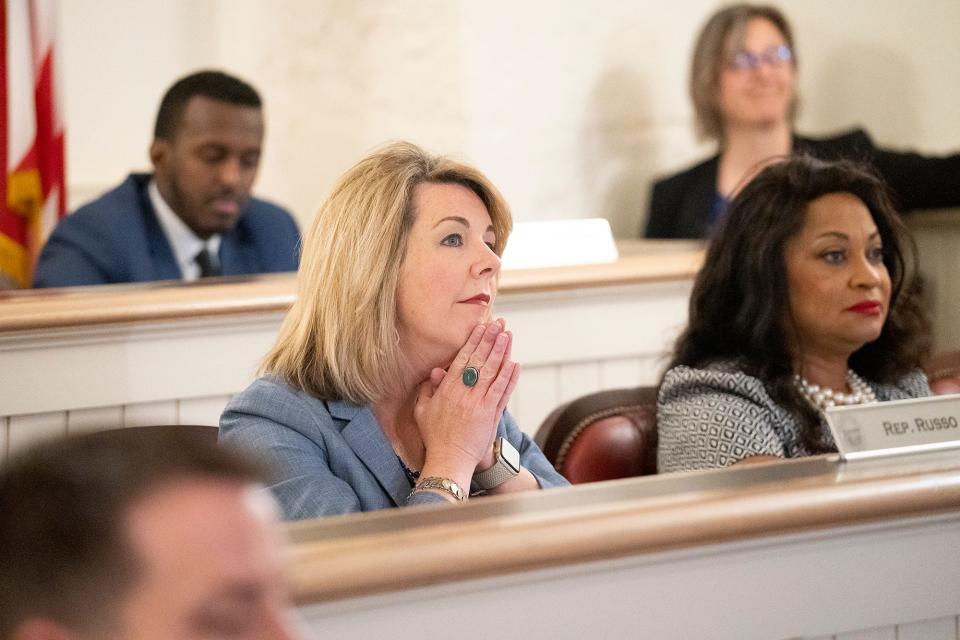
Russo refused to accept there was nothing she could do. She sparred with Huffman during hearings, penned opinion pieces, and tried her best to reach the people outside that committee room because they're the ones who can demand a new process.
"But she never loses control," Antonio said. "Those eyes flash and you know she is not happy with whatever just happened, but at the same time she always remains controlled, composed."
Instead, Russo leans into her stern "mom voice" when calling out what she describes as misbehavior and "a lack of political courage" by some in the GOP.
"She's got this dry observational wit," Walters said. "Like if a person touches the stove and it’s hot, she’s like 'Oh, did you burn yourself?'"
Some of her messaging is more subtle. Russo bought pride earrings for her members to wear on the day House Republicans voted to ban transgender girls from female sports teams and outlaw hormone therapy for transgender minors.
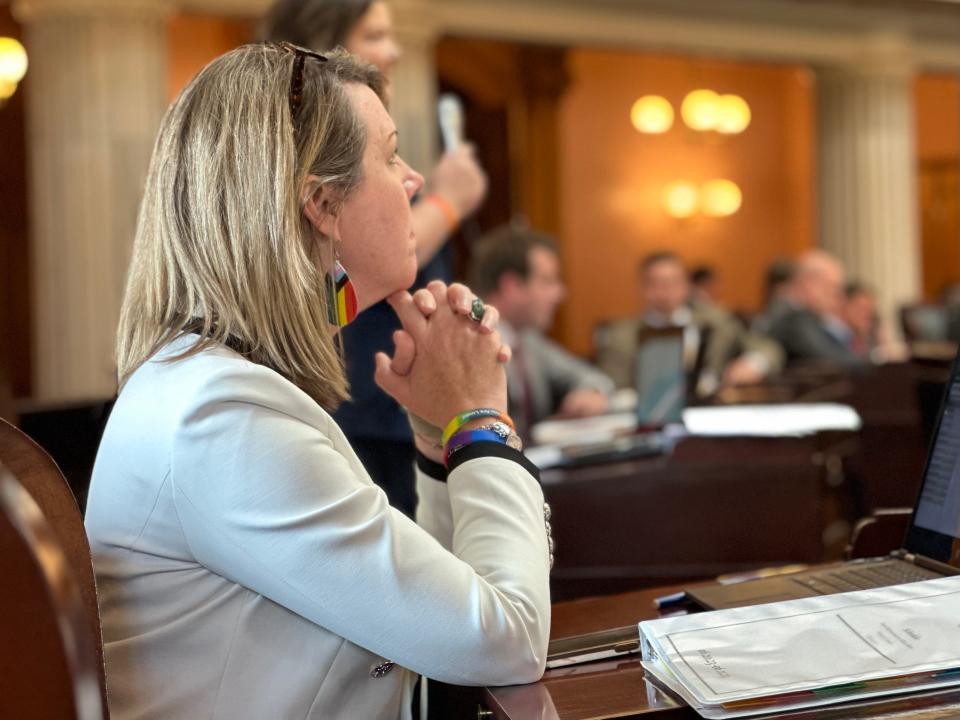
She loves statement earrings and felt it was important to show her support for LGBTQ Ohioans visually as well as verbally.
Political showmanship wasn't something that came naturally, though. Russo characterized herself as a "highly functioning introvert" who prefers policy papers to public speaking.
"I’m not even sure it’s performative," Russo said. "There is value in showing the public where your values are ... especially when you are in the minority. I don’t shy away from that."
That's why she organized a protest of House Democrats during the vote to create an August special election to make it harder to amend Ohio's constitution.
More: You asked, we answered: What Ohioans need to know about the August election on Issue 1
Hundreds of protesters chanted outside the House chamber that day, but speaking from the gallery during a voting session is prohibited. Observers aren't allowed to hold signs either.
"We knew going onto the floor that it was going to pass," Russo said. "We wanted to be with the public in as strong a way as possible, and we made a decision that we would not go quietly."
So, she and her fellow Democrats hashed out a plan to draw signs on manila file folders, sneak them onto the floor and launch their own protest before the vote. Videos of the surprise demonstration went viral on social media and House Speaker Jason Stephens, R-Kitts Hill, stopped the session for about 13 minutes.
House Democrats stand up and start a chant against a vote to create an August special election to make it harder to amend Ohio’s constitution. pic.twitter.com/SxNblK0oD6
— Anna Staver (@AnnaStaver) May 10, 2023
Stephens declined to comment through a spokesperson, but Russo said her actions were "in defense of the voice of the people." A point she hammered home during her floor speech.
"I ask the members of this chamber a question: How stupid do you think the people of Ohio are?" Russo said before the resolution passed. "Do you think the voters do not see through the lies that you are feeding them?"
What impressed Walters about that day was the fact that Russo got all her members on board with the idea.
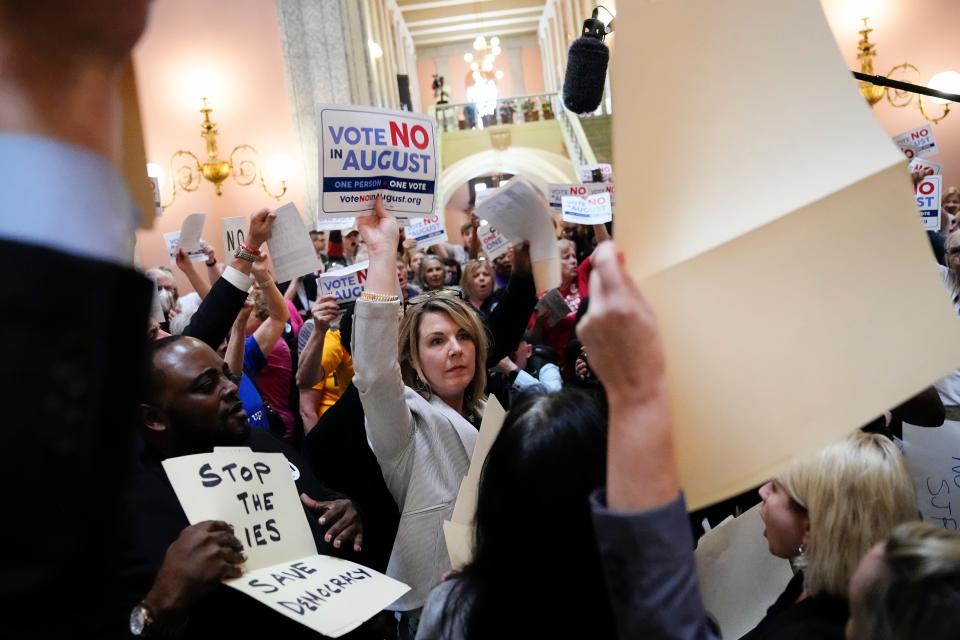
"Being in the minority doesn’t automatically equal cohesion," Walters said. "One of the things I see the most in her is this incredible ability to build relationships within her caucus. It's bananas in the best way possible."
All 32 House Democrats got behind a plan to help Stephens become speaker in January. The GOP had informally chosen Rep. Derek Merrin, R-Moncolva Twp. But in a surprise turn of events 22 Republicans banded together with Democrats to pick Stephens. Russo even held the Bible for him when he was sworn in.
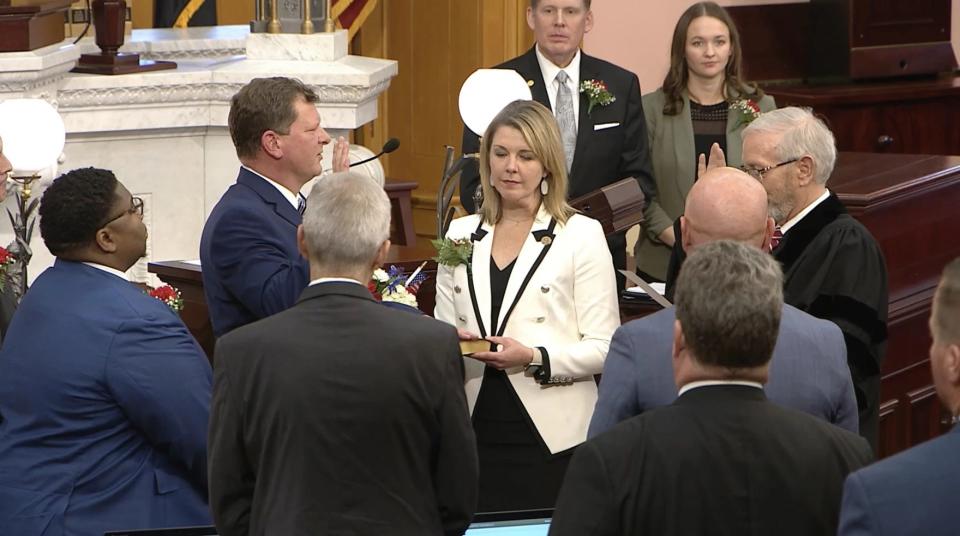
"I know people think we created this sort of this 'Kumbaya' coalition government. It's not," Russo said. "We never had that expectation that it was going to be that."
Merrin saw it differently. He's repeatedly referred to Russo as the de facto speaker during interviews with reporters, saying she represents the majority of representatives who elected Stephens to the job.
More: 'I'm the leader': Derek Merrin lost Ohio House speaker fight but says he leads GOP caucus
The House's version of Ohio's two-year budget included more money for public schools, a middle class-income tax cut, oversight for schools that take vouchers, incentives for first-time home buyers, a significant increase in eligibility for subsidized childcare and more money for food banks.
"I think that is probably just an excellent example of the potential for what Ohio would actually look like if we had a tight majority minority legislature," Russo said. "I think the Senate budget is a great example of what we do have."
In the end, Ohio ended up with universal eligibility for school vouchers, more money for public schools and a complete overhaul of the Ohio Department of Education. No Senate Democrats supported the final budget and those in the House were split.
"The school funding formula would not have stayed intact were it not for the work they did," Antonio said. "She stays positive and goal-oriented. That's how you successfully maneuver as a leader in a minority caucus, and I just think she’s doing an impressive job of it."
How to pick your moments
Russo's ability to make the most of the cards she's been dealt also impresses political observers like Niven.
"This is a person who is a legitimately skilled political player, who is playing in a game where the cards are stacked against her," Niven said. "I think she has achieved the least worst outcomes possible for her party, which is admirable and impressive. But what a limited triumph that is."
And if Ohio keeps trending red, it may be the only kind of victory Democrats have.
"The Democratic party has changed more than the state has changed," Triantafilou said. "I grew up in a union household, and those voters have just migrated away from Democrats. That’s made it harder for them to win in a state like Ohio."
He believes Buckeye voters want more parental control over education, lower taxes and stronger punishments for those convicted of violent crimes. He also thinks voters have real concerns about social issues like transgender athletes.
Brown, Ohio's senior U.S. senator, has been the exception to this rule. He's the only Democratic politician Ohioans still elect to statewide office, and his enduring appeal to working-class voters who flipped from President Barack Obama to Trump makes him more than a political outlier.
He's a template, perhaps, for how to win as a Democrat in a red state. Brown is known for keeping a deep connection to leaders all over the state and Walters sees the same thing from Russo.
The minority leader attended events in all her members' districts during the weeks leading up to the November 2022 election.
"I know people think that I do this all by myself, but I don’t. It's very much a team approach ... ," Russo said. "I’m a big proponent of just laying everything out and let’s see how the discussion goes. I think my members appreciate that I’m very transparent and provide as much information as possible so they know what their options are."
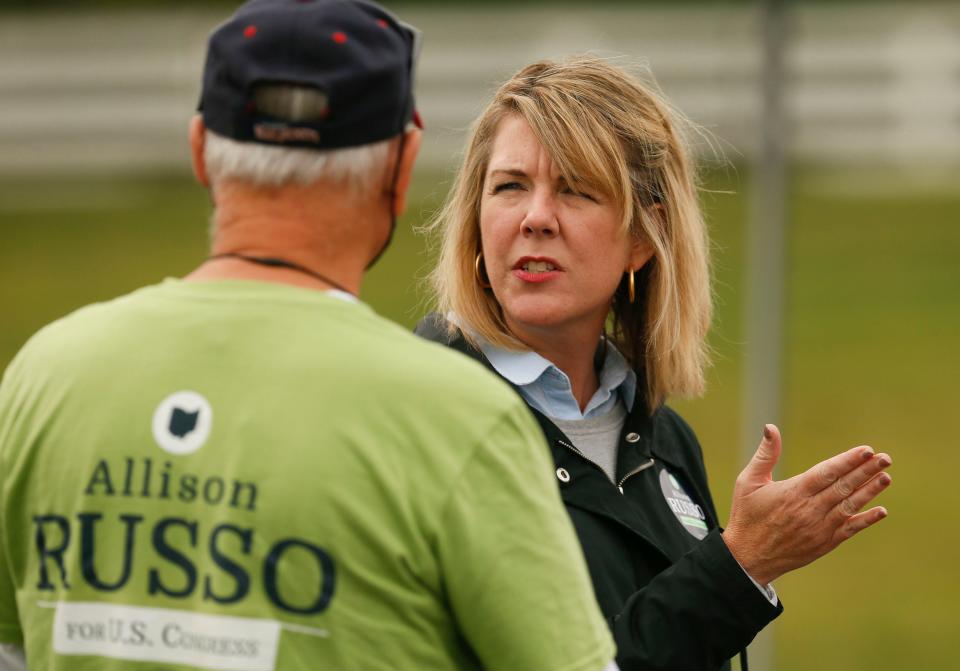
When Russo ran for Congress in 2021, she improved Democratic turnout in the deeply red spaces between Columbus and Athens and won a bigger vote share than any Democrat since the district was drawn in 2012.
But Russo still lost to U.S. Rep. Mike Carey 58% to 42%.
Democrats say that's evidence of how gerrymandered Ohio's districts are. Republicans say it shows voters are on their side.
"(Former U.S. Rep. Tim Ryan) spent millions of dollars trying to convince Ohioans that he is that old school Democrat," Triantafilou said. "That brand is so damaged in Ohio" that he doubts anyone − even Brown himself − can win them back.
He suspects Democrats will soon be stuck managing political traffic jams for rarely open congressional seats in Ohio's major cities.
Niven didn't disagree. But he added the caveat that political upsets are always possible, and they often come down to timing. Part of the reason Brown handed DeWine one of his only political losses in 2006 was the backlash to the Iraq war and President George W. Bush.
Winning a seat in Congress or statewide office "will require timing and luck," Niven said. "She needs to avoid missing out whenever that door opens."
The question is whether that's what Russo wants.
She doesn't have "a specific plan" once term limits force her to leave the Ohio House in 2026, and "some days I also love the idea of just going back to anonymity and going back to being a normal person."
Right now, she's focused on winning a final term in the House in 2024. After that, she'll think about 2026. Three years can be an eternity in politics.

America flipped from a GOP-controlled Congress with Trump as president in 2017 to a Democratic trifecta in 2020. That's also the timeline of former Ohio House Speaker Larry Householder's slide from powerful politician to prisoner.
But Ohio is trending redder with every election. Every Democrat who sought statewide office in 2022 lost by double digits except for Ryan, who lost by 7%.
"What Democrat of any stature is lining up to run for auditor?" Niven said. "The answer is none. They understand what a punishment that is right now."
Still, Walters cautioned Republicans against blithely dismissing candidates like Russo, saying one should never "underestimate the ability of a smart, talented mom to get s--t done in a difficult environment."
Anna Staver is a reporter for the USA TODAY Network Ohio Bureau, which serves the Columbus Dispatch, Cincinnati Enquirer, Akron Beacon Journal and 18 other affiliated news organizations across Ohio.
This article originally appeared on The Columbus Dispatch: Ohio looks like a red state. What will it mean for Democratic rising stars?


